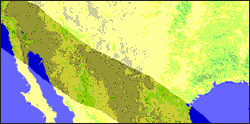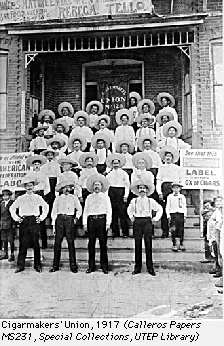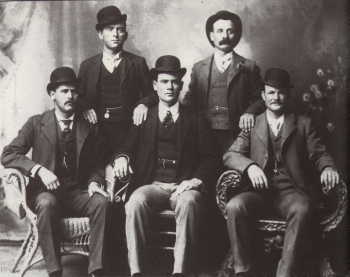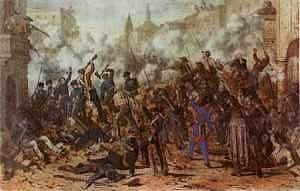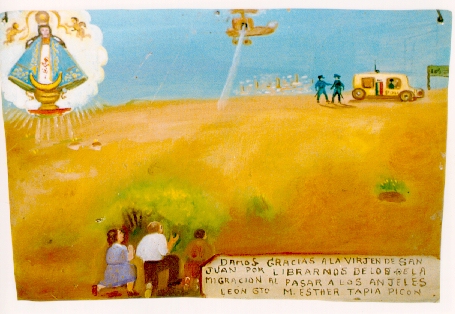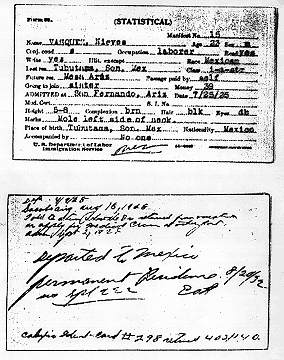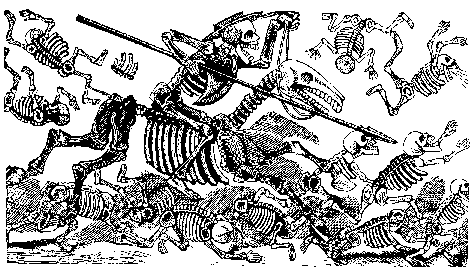"Viva Computer Links not Chain Links!":
Andrew G. Wood and Travis Du Bry
The borderlands between Mexico and the United States have long been a region characterized by both fascination and misunderstanding. First established after the Mexican-American War in 1848, the 2,000-mile dividing line between the two nations is today the subject of much concern for academics, journalists, businesspersons, politicians, and citizens of both nations.
In part, the 1994 passage of the North American Free Trade Agreement (NAFTA) has done much to promote new discussion—not to mention controversy—about the border. Following the establishment of maquiladoras (assembly plants) in the 1960s, grievances sparked by factory closings in the US as well as unfair labor practices in Mexico have increasingly gained public attention. Today, federal officials scramble to police the flow along the US-Mexico border by spending more money on keeping unwanted Mexicans out while at the same time promoting free trade. Yet the highly contentious social, cultural, and political discourse which characterizes the frontier zone between Mexico and the United States is an exchange which has a longer history. Since the turn of the century, Mexicans and their Anglo neighbors have engaged in an on-going—and often heated—debate about commercial trade, the environment, poverty, morality, and of course, immigration. Through by no means a comprehensive survey, our purpose here is to provide an introduction to border history and social science research currently available on the Web.
With several links connecting viewers to a wide range of resources—discussion groups, information sites, research libraries, the National Park Service homepage, "selected images of the American West" from the National Archives, merchandising sources, and travel tips—The American West has all the ingredients for the making of, as Richard Slotkin would put it, a real "Gunfighter Nation." Yet while the creators of this Web site proudly proclaim that The American West is "a celebration of the human spirit" and that "we are all pioneers, pathfinders on the trails of old and new frontiers," virtually no mention is made of Spanish Americans (i.e., Mexicans)—the region�s second great wave of colonists after "native" Americans. What little discussion can be found is reserved for the section on the Alamo. Those wanting to know more about the history of the Mexico-US borderlands must look elsewhere. One place to start is by subscribing to the Spanish Borderlands (SPANBORD) listserv at Arizona State University. This discussion group offers an ongoing exchange regarding research and topics of interest regarding the entire Spanish-American world from the Caribbean to California. Moving closer to Mexico and the creation of the US Southwest, a Web page dedicated to the 1846-1848 Mexican American War offers Internet users a virtual tour of historic battle sites thanks to an organization known as The Descendants of Mexican War Veterans. Much of the material provided is oriented towards the historical preservation of various battlegrounds in Texas, New Mexico, California and throughout northern Mexico. Each link offers valuable information for visitors interested in touring any of these historic areas. Little discussion, however, is provided regarding the larger significance of the conflict. The creators of this site are also silent about the bitter resentment felt by many Mexicans over the loss of nearly half their national territory in the war. For more scholarly inquiries, the Canadian
based Guerre
du Mexique site provides a number of helpful resources
for those wanting to learn more about the Mexican-American War.
Bibliography, academic papers, and sample documents are available for
reading on-line.
Turning to the Mexican Revolution, the Historical Text Archive site makes a number of documents available for browsers. It operates as a source for historical documents online. Included are sections on Francisco Madero, Pancho Villa, and Emiliano Zapata. Zapata's Plan de Ayala, the infamous Zimmerman telegram, and a version of the 1917 constitution in English are available. The site also hosts information related to all periods of Mexican history as well as Latin America and the world, making this an excellent educational tool. More limited sites devoted to the Mexican Revolution include the US�Mexico Border Labor History project at the University of Texas El Paso. Housed at the Institute of Oral History, this Web page lists a number of resources available for those interested in border history. Online access to materials is restricted, however, to a handful of historic photographs. Similarly, the Texas A & M University Cushing Library oral history project provides a listing of interviews with Mexicans who immigrated to Texas at the time. Unfortunately, the actual transcriptions are not available online. For a wide variety of historic photographs of Mexico and the US�Mexico borderlands, the Detroit Publishing Company 1880-1920 has 575 photos of Mexico (many by William Henry Jackson) available for online viewing. For those focusing on immigration during more recent decades, the Mexican Migration Project site co-coordinated by Jorge Durand (U Guadalajara) and Douglas Massey (U. Pennsylvania) offers browsers access to oral histories of Mexican migrant laborers as well as several retablo texts which, according to Durand and Massey: �are works of art, old and deep-seated religious expressions, depicting the migrants' experience. The texts, which complement the retablos, give a brief explanation for the reason a migrant prayed or gave thanks to a particular Saint or Virgin. The texts capture not only the physical, but also the social phenomena, of Mexican migration. It allows one to see that making the decision to migrate is not simply an economic phenomena, but rather a cultural, emotional, and religious phenomena.
The various accounts Durand and Massey have assembled make for interesting reading. Other links provide more detailed information on their work. Finally, the HTML version of the 1994 textbook The Shared Experience by the Los Caminos del Rio Heritage Project and the Texas Historical Commission offers browsers a well-crafted introduction to borderlands history. While brief, the text offers a concise presentation for students as well as a number of helpful bibliographic references. Generally, our survey of sites focusing on the
history of the US-Mexico border discovered quite an array of visual
materials and general information available for use. Access to
primary documents, however, proved more difficult. Hopefully this
situation will change as researchers and libraries continue not only
to list but place their collections online. In searching for more
contemporary information on the borderlands, we found several exciting
and sometimes unusual sites.
A wealth of information on the environment, population, labor, and other topics can be accessed via the Internet. Border Pact is a fully bilingual/bi-national site claiming to "foster change in the US-Mexico Borderland in collaboration with border institutions of higher education." Featuring four main sections which include database and discussion groups, background info, resources, and convenors. The "Database and Discussion Groups" section provides access to a collection of institution and agency profiles. In many cases, however, those wanting to use this service must first register. Border Pact discussion groups offer exchanges on a variety of themes including: education, community, environment, health, urban infrastructure, economic development, housing, transportation, maquiladora plants, agriculture, women�s and children�s issues, migration, pesticides, bilingualism, small-business, and tourism. All are organized by state. Border Pact also provides links to El Net
which offers a listing of bi-lateral and tri-lateral events. Other
useful links include: Border Information and Solutions Network-Link—a
project focusing on sustainable development out of Brownsville, TX;
North American Linkages to Global Environment Strategies (NALGES)—a
site concentrating on environment issues; Red Fronteras�which is a network
of various academics, students, and resources concerned with the border,
and the San Diego�Tijuana Interactive Atlas—an excellent source for
other links as well as demographic and housing statistical data on both
sides of the border. Probably one of the best visual connections
provided by Border Pact is the interactive atlas that allows one to select a topic from an array of themes (i.e. sewer connections, population, infrastructure,
census data) for specialized map production.
A helpful site for exploring various environmental issues is the Borderlands Environmental Archives. While this is a commercial travel Web page, it is also a helpful site for border links. Categories include: new sites, publications, NGO�s, state and regional government, national/bi-national government as well as academic centers in Mexico and the United States. Mostly geared towards so-called "eco travel" south of the border, those interested in exploring border issues will find this a suitable base for departure. For adventurers specifically interested in environmental issues, the US Mexico Border XXI site is a bilingual Web page sponsored by the US Environmental Protection Agency. In addition to detailing their objectives, projects and overall mission, this site makes available several reference maps of border regions broken down into state-to-state sections as well as a long list of environmental links. For navigators wanting to visit virtually the halls of academia, the Center for Interamerican and Border Studies at the University of Texas at El Paso is a good place to start. The Center�s Web page is divided into the following sections: Mission Statement; Center Description and Fact Sheet on Border Studies; Paso del Norte (material on NAFTA), Guide to Juárez; El Paso Homepage (local info); University and organization links and; Center Publications. In addition to learning about what scholars in El Paso are doing, the Center�s bibliography provides a number of good listings of publications concerned with the border. Further on up the road, the Latin American Network Information Center UT Austin site is a fully bilingual, highly resourceful Web page dedicated to the study of Latin America in general. Visitors will find a huge repository—a virtual clearinghouse—of information and links. Among the many goodies here is a country directory for all of Latin America cross-listed with a subject directory. Under Mexico, for example, our friends in Austin have assembled a wide variety of links organized by the following categories: arts and humanities, discussion groups, economy, trade and finance, general information, history, indigenous peoples, government, magazines and periodicals, NAFTA resources, news, politics, popular culture, science and technology, states and cities, travel and tourism, university servers and finally, searchable WWW subject indexes. For the US/Mexico section, one will find interesting resources organized under sections labeled academic links, colonias and housing, and environment as well as most of the areas listed above. For those with specific interests in border settlements (colonias), the Center for Housing and Urban Development Colonias Program at the Texas A & M College of Architecture site offers a good bibliography on a wide variety of colonias related topics as well as many links.
The Borderlines
Newsletter is a monthly bilingual publication with analysis
of environmental, social, economic, and political issues pertaining
to the US-Mexico borderlands region. It also offers a long
list of organizational contacts and Web sites related to labor, environment,
and immigration issues. Border Beat
is another newsletter focusing on border arts and culture.
For those wanting information direct from Mexico, Mexico Online provides a host of links to Mexican newspapers (including La Jornada, Reforma, El Diario de Monterrey, El Norte and several others). All offer a wealth of information on tourism, business, arts, and politics. In addition the many sites mentioned above, there are a few more eccentric points of interest which should also be mentioned. For Internet voyeurs, the Eye in the Sky Camera Web page provides viewers with fresh pictures of "border crossings" at the International Bridge 2 at Laredo/Nuevo Laredo every five minutes. Various journalistic efforts focusing on the border include Atlas Magazine�s photo essay called "Patrolling Despair" by Olivier Laude. Here, viewers may follow the story of a group of undocumented migrants across the Río Grande by way of instamatic photos and captions posted on the Web. Last but not least, the Virtual Texan Web site has constructed a photo essay on migrant workers titled "Fruit of Their Labor." The article, from a local newspaper, covers the daily trials migrant workers face in and out of the hot, dry agricultural fields near the US-Mexico border. With all the sites available—and many more surfacing daily—information on the complexities and controversies pertaining to the US-Mexico border region will become more accessible to greater numbers of people in years to come. In closing, we would like to direct the reader's attention to the rather transient nature of the Internet. What is here today is not guaranteed to be there tomorrow, and sites are often moved to another location without pages that redirect browsers to new addresses. Quite a few of the sites that we included when this article was originally submitted for publication had to be hunted down again for their current URL's. (All sites were active as of 10/20/99.) We strongly advise readers to save to disk or print out Web pages that contain information relative to their interests. The Internet can be a great place for information, but only if that information can be found consistently.
Andrew G. Wood and Travis Du Bry
~ End ~
"Viva Computer Links not Chain Links!": |
